Comparison of Ozone Fluxes over a Maize Field Measured with Gradient Methods and the Eddy Covariance Technique
Zhilin ZHU, Xinzhai TANG, and Fenghua ZHAO
1Key Laboratory of Ecosystem Network Observation and Modeling, Institute of Geographic Sciences and Natural Resources Research, Chinese Academy of Sciences, Beijing 100101, China
2College of Resources and Environment, University of Chinese Academy of Sciences, Beijing 100049, China
ABSTRACT
Key words: ozone flux, eddy covariance, gradient method, ozone gradient, eddy diffusivity
1. Introduction
Although only approximately 10% of the total O3is in the troposphere (Krzyscin et al., 2007), as a secondary pollutant near the ground, tropospheric O3is known to have negative effects on human health, vegetation, and ecosystems(Massman, 2004; Cape, 2008). In China, rapid industrialization and urbanization have been resulting in increases in the atmospheric O3concentration, threatening human health and crop yields (Feng et al., 2015; Fu et al., 2019).
To quantitatively assess the effects of O3on vegetation and ecosystems, several O3concentration—based and stomatal flux—based indices have been proposed and applied in recent decades (Musselman et al., 2006; Karlsson et al.,2007). Considering the amount of O3entering vegetation stomata, some studies have shown that the effect of O3on vegetation is more closely related to the stomatal O3flux (Paoletti and Manning, 2007; Pleijel et al., 2007; Mills et al., 2011).Measuring the O3flux over ecosystems is an important step for calculating flux-based indices. In addition, the O3flux can also facilitate our understanding of O3deposition processes.
Currently, two main micrometeorological techniques,the eddy covariance (EC) method and gradient method, are applied to measure the O3flux (Grünhage et al., 2000).Although there are some errors and uncertainties in the EC method (Massman and Lee, 2002), it is considered the best direct flux measuring method and is widely used for carbon dioxide (CO2) and water flux measurements (Baldocchi,2003). Nevertheless, the EC approach to O3flux measurement is currently not very popular, as the fast-response O3analyzers employed for the task do not perform as well as CO2and H2O gas analyzers (Muller et al., 2010; Zahn et al.,2012). For example, an O3analyzer’s sensitivity is variable owing to the consumption of O3-sensitive dye and changes in environmental conditions (Güsten et al., 1992). It needs a slow analyzer to simultaneously calibrate it nearby, which could result in different fluxes when using different calibration methods (Zhu et al., 2015). The EC technique avoids measuring the O3gradient, which is considered to be the main source of uncertainty in O3fluxes measured with gradient methods, resulting in the EC-measured O3flux being considered more reliable (Muller et al., 2009; Loubet et al.,2013).
Although the EC method for O3flux measurements is becoming increasingly popular at present, the gradient method is still used for measuring O3flux and has been improved (Muller et al., 2009; Bocquet et al., 2011; Mayer et al., 2011; Loubet et al., 2013). For the traditional gradient method, the largest uncertainty comes from the error of O3concentration differences or a small gradient that is often the same order of magnitude as the analyzer’s precision.Recently, Wu et al. (2015) proposed a modified micrometeorological gradient method for estimating ozone flux over a forest canopy, in which the O3gradients were calculated from the O3concentrations between a level above and a level below the canopy top. The advantage is that the relatively large gradients between these levels make this method more stable. Compared to other traditional gradient methods, it was the closest in magnitude to the EC measurements.
The gradient method for determining O3flux is the product of eddy transfer diffusivity and the O3concentration difference (gradient) at two or more heights. The O3gradient can be measured directly with analyzers, while the eddy transfer diffusivity is usually obtained by measuring other variables in the context of Monin—Obukhov similarity theory (MOST), i.e., the eddy transfer diffusivity for all scalars is assumed to be the same (Foken, 2006). Thus far, three methods for determining transfer diffusivity have been widely applied. The first method is based on momentum transfer diffusivity, which can be obtained by measuring the temperature and wind speed gradients (Baldocchi and Meyers,1998; Bocquet et al., 2011). Although all variables in this method are easily measured with routine instruments, the high-precision gradients are difficult to obtain. The second method uses the universal flux—gradient relationships. In this way, the transfer diffusivity could be determined without requiring temperature and wind speed gradient measurements, if the friction velocity (u*) and sensible heat flux(H) are measured by the EC technique (Loubet et al., 2013).This method overcomes the uncertainty in gradient measurements. The third method is the modified Bowen ratio(MBR) (Meyers et al., 1996; Walker et al., 2006; Mayer et al., 2011). This requires the measurement of another scalar flux (e.g., sensible heat, H2O, CO2) and its corresponding gradient over the same heights. The scalar flux can be measured with the EC technique, and its corresponding temperature or gas concentration gradient should be measured at the same heights. The inversely derived exchange coefficient of the scalar flux can be assumed to be equivalent to all scalar quantities in the ecosystem. Although fluxes can be measured with the EC method, it still requires the measurement of scalar gradients. Different methods might result in different transfer diffusivity values.
Although the gradient method is not as good as the EC technique, it has the advantage of being easy to apply broadly without an expensive EC system and fast-response O3analyzer. Nevertheless, investigators should first be familiar with the accuracy and precision of the gradient method.The main motivation of this study was to evaluate the performance of the gradient method by comparing its results with the EC O3flux. Compared with previous studies, the novelty of this study is the evaluation of the performance of three gradient methods for estimating O3flux by comparison with the EC technique. Meanwhile, the effects of the measurement and calculation methods of the O3concentration gradient were analyzed. The specific objectivities of this study were to: (1) compare the difference and analyze the effects of diffusion coefficients calculated by different methods; (2) analyze the effects of different gradient calculation and measurement methods; and (3) evaluate the performance of the gradient method compared to the EC method for measuring the O3flux.
2. Materials and methods
2.1. Site, instruments, and measurements
Measurements were executed during daytime[0500—2000 LST(LST=UTC+8)] from 2 August to 28 September 2017 over a summer maize (Zea mays) field at the Yucheng Comprehensive Experimental Station, Chinese Academy of Sciences (36°57’N, 116°36’E; 36 m MSL). During the experiment periods, the maize was in the flourishing stage and its height was constant. The site was located in the Yellow River alluvial plain of the North China Plain,Shandong Province, China. The surface soil texture at the station was that of a silty loam with moderate salinity and alkalinity. The experimental site was fairly flat, and the fetch requirements for flux measurements were well satisfied within 200 m of the instrument locations. During the observation period, the mean crop height was 2.2 m.
Gradient measuring sensors and EC instruments were installed at two masts separated by a horizontal distance of approximately 3 m. For gradient measurements, all sensors or air sampling inlets were mounted at 4.70 m and 3.15 m.Two temperature and relative humidity sensors (HMP155A,Vaisala, Finland) were housed in special radiation shields.Wind speeds were measured with two 2D ultrasonic wind sensors (WMT700, Vaisala, Finland). The two-height O3concentrations were measured with a slow-response UV photometric O3analyzer (Model 205, 2B Technologies Inc.,USA; hereafter referred to as M205). Its measurement precision is 1.0 ppb, with a resolution of 0.1 ppb. By using two solenoid valves, two-level air samples were cyclically (switching once per 5 min) drawn down into an analyzer with two separate inlet lines (PTFE Teflon) that were 5.5 m long with 4-mm inner diameters.
The EC O3flux was measured in combination with observations from the Chinese Terrestrial Ecosystem Flux Observational Research Network (or ChinaFLUX). The instrumentation included a 3D sonic anemometer (CSAT3, Campbell Scientific Inc., USA) and an open-path CO2/H2O gas analyzer(LI-7500, LI-COR, Nebraska, USA) for measuring sensible heat, latent heat, and CO2fluxes. The O3fluctuation (in mV) was measured with a closed-path fast-response O3analyzer that was cooperatively developed by Karlsruhe Institute of Technology and Enviscope GmbH (Germany) (Zahn et al., 2012; hereafter referred to as ENVI). Air was drawn down through a 4.5-m-long tube with a 4-mm inner diameter at a flow rate of 2.4 l min-1and passed over a small disc coated with O3-sensitive dye. Its output signal (in mV)was positively correlated with the ambient O3concentration (Muller et al., 2010). Because of the continuous consumption of O3-sensitive dye, we replaced the dye disc every 3—4 days, approximately. Radiation variables were also measured, including net radiation (CNR1, Kipp & Zonen, The Netherlands) and photosynthetically active radiation (LI-190SB, LI-COR, Nebraska, USA). All radiation and EC sensors were installed at a height of 3.5 m.
All gradient measurements were sampled with a frequency of 0.1 Hz, and the averages for every 5 min were recorded by a data-logger (CR3000). All high-frequency vector and scalar raw data were continuously sampled and stored using a SMARTFlux system (LI-COR, Nebraska,USA) with a frequency of 10 Hz.
2.2. Gradient methods
According to Fick’s first law, the scalar flux in the constant-flux layer can be expressed as the product of the vertical concentration gradient (∂ c/∂z) and eddy diffusivity(Kc) (Grünhage et al., 2000):

Usually, the gas concentration vertical gradient is obtained by directly measuring concentrations at two or more layers with one or more gas analyzer(s), while Kcis obtained from other measurements. Based on MOST, the eddy diffusivity for O3can be assumed to be equal to the diffusivity for momentum, heat, water vapor, and trace gases.To assess the differences in the calculated Kcfrom using the different methods, three methods were selected in the present study, as briefly described below.
2.2.1. Aerodynamic gradient method
The first method, the aerodynamic gradient (AG)method, is based on the gradients of temperature, wind speed, and gas concentrations. As the two measurement heights of three variables are the same, the AG method O3flux can be calculated as (Bocquet et al., 2011):

where κ is the von Karman constant (0.4 in this study), d is the zero-plane displacement, estimated by the equation d =0.67hc(hcis maize height), and z2and z1are the heights of the upper and lower sampling inlets and meteorological sensors, respectively. Φmand Φcare stability function of momentum and scalar, respectively. ΔU and ΔCO3are the mean gradients of the wind speed and O3concentration,respectively, the overbar denotes average, and KAGis referred to as the exchange coefficient and is also called the transfer velocity (Meyers et al., 1996; Wolff et al., 2010).Note that the effect of the height difference (Δz) is subsumed in the exchange coefficient K with units of velocity(Meyers et al., 1996). The stability correction factors are calculated by:

where the Richardson number (Ri) is estimated by:

where g is the gravitational acceleration (9.8 m s-2), Δθ is the potential temperature gradient, and Δzuand Δzθare the height differences in the wind speed and temperature, respectively. As the mean air pressure is very close to 1000 hPa,the potential temperature was replaced with the air temperature.
2.2.2. AG method combined with EC measurements
Since the EC system was employed in this experiment,the u*and H can be obtained directly. Therefore, the Kccan be calculated using the universal flux—gradient relationships method (Businger et al., 1971). The O3flux calculated with this AG method with EC measurements (hereafter referred to as the AGEC method) can be written as(Rinne et al., 2000):

where the u*and Obukhov length L are taken from the EC measurements. Ψhis the integrated stability correction function for heat calculated using the Businger—Dyer equations(Paulson, 1970; Businger et al., 1971).
2.2.3. MBR method
Based on the measurements of fluxes (momentum, sensible heat, and latent heat fluxes) and gradients (wind speed,temperature, and relative humidity), three MBR exchange coefficients could be calculated. In this study, the exchange coefficient with the MBR method was based only on the H and temperature gradient, and the O3flux for MBR was calculated as (Walker et al., 2006):

where w is the vertical wind speed (m s-1), w′T′is the kinematic heat flux (K m s-1) measured by the EC method, the overbar denotes the time average, and the prime signs indicate the fluctuation of each variable. ΔT is the vertical gradient of air temperature (K). The ratio w′T′/ΔT can be considered the exchange coefficient or the transfer velocity of the O3flux.
2.3. EC O3 flux calculation
As the ENVI’s output is a relative measure of the O3concentration, and its stability is affected by the consumption of O3-sensitive dye and environmental conditions, it must simultaneously calibrate. In this study, the “ratio method” was used to calibrate the ENVI’s signal-output (X), meaning that X (in mV) is proportional to the absolute ambient O3concentration over a 30-min period (Muller et al., 2010). Based on this assumption, the O3deposition velocity (Vd), defined as the O3flux divided by the O3concentration, can be calculated by:

where the role of the minus sign in Eq. (8) is to maintain a positive Vd, because the O3flux is always directed downward (negative). The raw EC O3flux, FO3_EC, can be given as:

In practice, the O3flux and other EC data were processed by EddyPro®software (LI-COR, NE, USA) with a series of corrections. The double rotation method was used to correct the error due to non-level terrain (Wilczak et al.,2001). Ozone flux loss caused by time delay was corrected by the maximum covariance method (Moncrieff et al.,1997). The frequency response attenuation due to tubing was corrected using methods described by Ibrom et al.(2007). The Webb-Pearman-Leuning (WPL) correction(Webb et al., 1980) term only considered density variations caused by water vapor (Zhu et al., 2015).
3. Results and discussion
3.1. Comparison of the exchange coefficients from different methods
Exchange coefficients (K) are key factors for gradient method fluxes. Different methods of determining K result in different exchange coefficients. Figure 1 shows the mean diurnal variations of the transfer coefficients calculated by the three methods. Overall, the variation trends in the three K types are the same, presenting an obvious diurnal variation pattern. With the increase in radiation and temperature, the air turbulence becomes strong, and the three K types are increased. Around noon, the maximum K appears with smooth changes. It starts to decrease in the later afternoon. However, large differences exist in the three K values. The K value determined by the AG method (KAG) is the largest, and the K calculated with the MBR method (KMBR)is the smallest.The KAGECvalue is between those of KMBRand KAG,and the variables for calculating KAGECare measured by the EC technique. It can therefore be considered the most appropriate, as validated by comparing its results with those of the EC O3flux (see section 3.3). The 30-min averaged KAGand KMBRare compared with KAGECin Fig. 2. Based on the scatterplot, coefficient of determination (R2), and significance level, it is clear that the correlation between KMBRand KAGECis better than that between KAGand KAGEC. Based on the linear regression equations, KMBRis approximately 0.08 m s-1lower than the KAGECin value, while the KAGis larger than the KAGECoverall. The difference becomes small when K is large. The mean values of KAGEC, KMBR, and KAGare 0.20, 0.12, and 0.25, respectively. KMBRis 40% lower and KAGis 25% higher than KAGEC.The differences in the exchange coefficients are affected by their calculation equations and the accuracy of each variable measurement. The large differences in the K values show that there were systematic errors in determining K with the different methods (see Fig.2). For KMBR, the error sources include the H and temperature gradient measurements. Wilson et al. (2002) evaluated the energy balance closure of 22 sites in FLUXNET and concluded that a general lack of closure existed at most sites, with a mean imbalance in the order of 20% in most conditions. The sum of the measured H and LE (latent heat flux) with the EC method, (H +LE)EC, is smaller than the difference in net radiation (Rn)and soil heat flux (G) (Rn-G). This may imply that the H measured with EC might be underestimated, leading to the underestimation of KMBR. Additionally, the error in the temperature gradient is dependent on the sensors’ performance.Although the best precision that the temperature sensors can reach is ±0.055°C, as the two temperature sensors were not exchanged periodically, a radiation shield could also result in a certain systematic bias in the temperature at the two levels (Loubet et al., 2013). To eliminate the systematic error of two temperature sensors, using thermocouples rather than the routine temperature sensors may be a good choice. It would be better if two temperature sensors could be exchanged regularly.
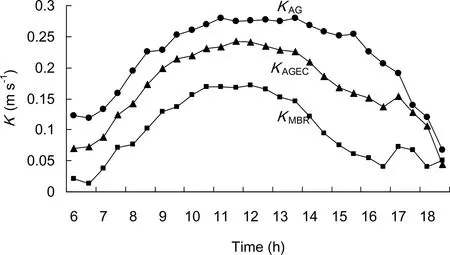
Fig. 1. Diurnal variations of the K calculated by the MBR,AGEC and AG methods.
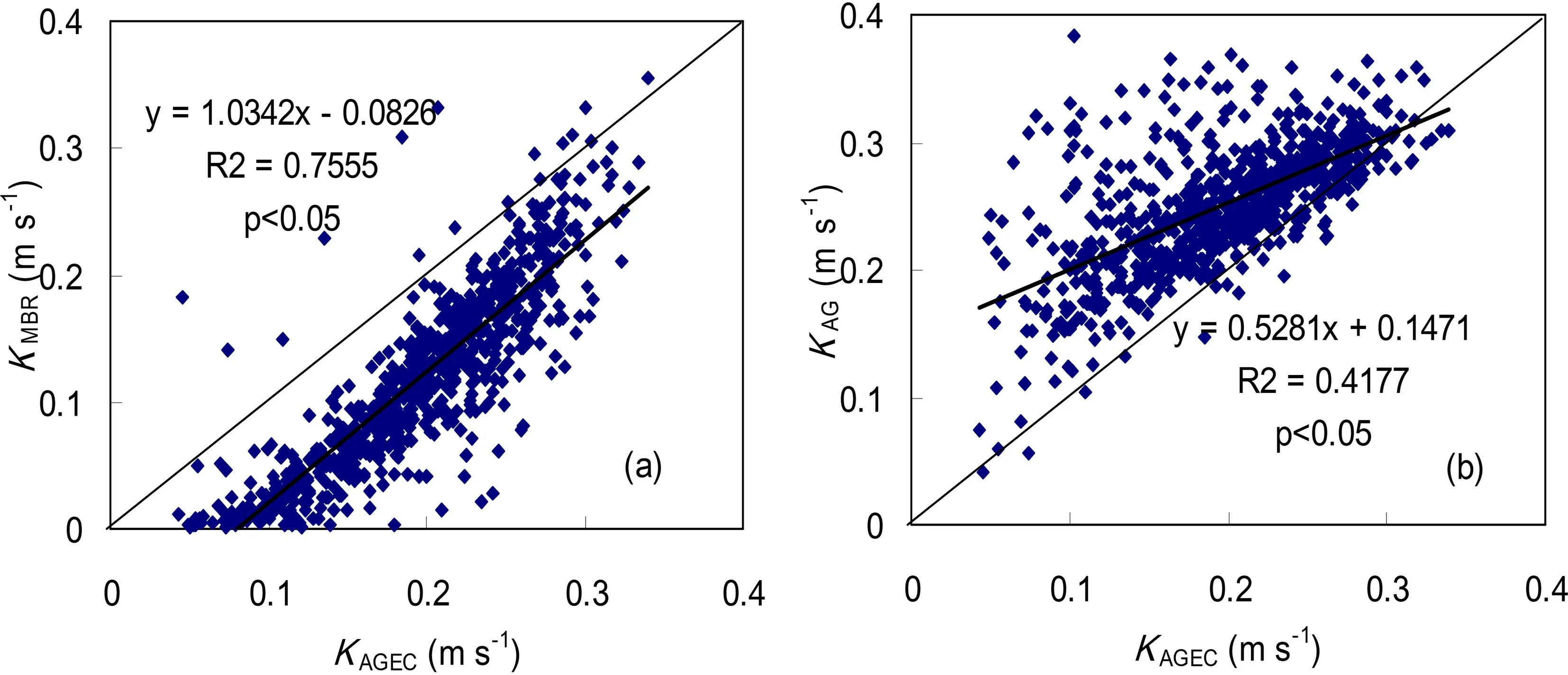
Fig. 2. Comparison of the 30-min K computed with the MBR, AGEC and AG methods.
The sources of error and uncertainty in KAGcome from the wind speed measurements, estimations of d, parameters of stability correction functions, etc. Wind speeds were measured with two new 2D sonic anemometers. The precision is±0.1 m s-1or 2% of the readings, and the initial wind speed is 0.01 m s-1(according to the manual). We can consider the accuracy to be sufficiently high and the random error to be very limited. These assumptions would ensure that the wind speed gradient is reliable. Improper stability correction functions in Eq. (2) might also be error sources. The commonly used universal models and parameters of the functions are usually based on previous literature that utilized empirical equations obtained at a specific site and in a specific condition. Different researchers have presented different stability correction models and parameters (Foken,2006; Song et al., 2010).
The error and uncertainty of zero-plane displacement(d) are dependent on the estimation method and parameters(Loubet et al., 2013). The commonly used method is simply estimated by the plant height (hc) being multiplied by a constant (usually in the range of 0.6—0.8). The second method is inversely derived from the flux—gradient relationships,and the scalar flux can utilize the EC measurements. The third method is estimated by linearly fitting the wind speed profiles U(z) and ln(z-d), making the root-mean-square error of the wind speed minimal in neutral conditions or making some corrections under non-neutral conditions. In this study, it was calculated as d = 0.67hc. To validate whether this is suitable, we compared the u*calculated by the third methodand the u*measured with the EC techniquerespectively. As seen in Fig. 3, the correlation is very good, with a slope of 0.99 and an R2of 0.8, indicating that the estimated d has no systematic bias.
3.2. O3 concentration gradient
Figure 4 shows the frequency distribution of the O3gradi-ent in the daytime during the observation period. Most gradients are distributed in the range between -6 μg m-3and 0 μg m-3, and the median of the gradient is -3 μg m-3. As the two-level O3concentrations were measured with the same analyzer, the systematic error caused by the analyzers can be ignored. However, the random error must still be considered. The uncertainty or relative error of the gradient depends on the magnitude of the real gradient that can be estimated by the ratio of the sampling errors (δΔCO3) to the gradient ΔCO3(Wolff et al., 2010). According to the manual, its precision and accuracy are greater than 1.0 ppb(approximately 1.9 μg m-3) or 2% of the reading, and its resolution is 0.1 ppb. This allows the small O3gradient to be detected, but it is difficult to quantitatively determine the uncertainty in the O3gradient. Nevertheless, a zero-gradient test could be used to roughly evaluate the precision and accuracy of the flux-gradient system. The larger the gradient (absolute value) is, the smaller the uncertainty of the gradient.
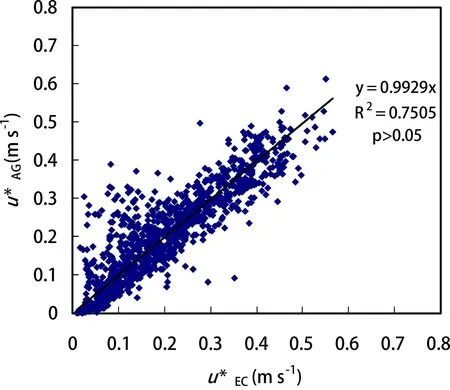
Fig. 3. Comparison of u* measured with the EC technique and AG method.
Figure 5 shows the mean diurnal variations of the O3concentration (average of two levels) and gradient during the entire observation period. The analyzer is a new product,and its precision can guarantee that the O3concentration is reliable. Compared to the ambient absolute concentration,the vertical O3gradient is very small within the ranges of several ppb. In the morning, the gradient shows increasingly larger trends. It is less than 2 μg m-3in the early morning(before 0900 LST), implying that there may be large uncertainty during this period. The change in the mean gradient is relatively stable in the afternoon, with a mean gradient of 3.6 μg m-3, starting to decrease after 1900 LST.
In general, the negative effects of O3on crops happen in the daytime and during high concentration conditions(Pleijel et al., 2007; Feng et al., 2015). This can be reflected by O3concentration—based assessing indexes (Dingenen et al., 2009), such as M7 [the 7-h (0900—1600 LST)mean O3concentration] and AOT40 (the accumulated hourly O3concentration above a 40 ppbV threshold). The mean gradient was more than 2.4 μg m-3in the later morning and afternoon at high O3concentrations (Fig. 5), implying that the uncertainty of the gradient is relatively small during the times that O3is affecting the ecosystem.

Fig. 4. Frequency distribution of the O3 concentration gradient.
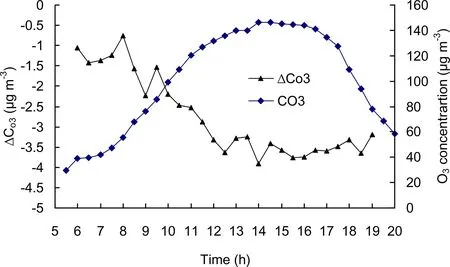
Fig. 5. Mean diurnal variations of the O3 concentration(average of two levels) and gradients during the entire observation period.
The accuracy of the O3gradient is a key variable for the O3flux measured with gradient methods. It depends on not only the analyzer’s performance but also the measurement and calculation methods. For example, the number of measuring heights is a source of uncertainty for the gradient. According to AG theory, the flux is proportional to the concentration changes with height. For only the two-level measurements, a few random errors in the O3concentration could result in a large bias in the O3gradient. Hence, measuring the concentration profiles at more heights would filter or smooth out the random error, and the gradient would be more stable.
Besides the number of measuring heights, it is noteworthy that the proper calculation method is very important for reducing bias in the O3gradient. In this study, the twolevel O3concentrations were measured alternately (in 5-min intervals) with one analyzer, in which there exists a measuring order issue (i.e., which 5-min O3concentration level is measured first during a 30-min period). A simple average of each of the O3concentration levels might produce certain errors without considering the measuring order. Table 1 presents an example of 30-min averaged O3mix ratio gradients with two calculation methods. In method I, the upper and lower 30-min O3concentrations are the simple reaverage of three 5-min measurements. As shown in Table 1,the upper concentrations were measured during 1000—1005 LST, 1010—1015 LST, and 1020—1025 LST on 21 August 2017. The lower concentration measurements were taken during 1005—1010 LST, 1015—1020 LST, and 1025—1030 LST on 21 August 2017. In method II, the gaps were first filled with the averages before and after the 5-min measured O3concentrations, and there were six 5-min data points for each height, including three measured and three gap-filled data points. The gradient was then calculated as the difference between the two-height O3concentrations.
It is clear that there are large differences in the O3gradients determined with the two methods (see ΔC1 and ΔC2 in Table 1). To demonstrate that method II is better than method I, we calculated the gradient of an offset of 5 min(i.e., 1005—1035 LST), in which the measuring order is changed. With method I, the O3gradients of 1000—1030 LST (-2.30 ppb) and 1005—1035 LST (0.15 ppb) are largely variable and even result in a change of sign. However, the variation in the gradients of 1000—1030 LST and 1005—1035 LST calculated with method II is very small (-0.81 ppb and -0.84 ppb).

Table 1. An example of a comparison of different O3 mix ratio gradient calculation methods.
Figure 6 shows the diurnal variations of O3gradients calculated with two methods and time ranges on 15 August 2017. In method I, the difference of two 30-min averaged O3gradients during different time ranges (5-min offset) is very large sometimes (see the two solid lines in Fig. 6).However, the difference with method II is obviously small(see the two dashed lines in Fig. 6). Even so, the difference means that there was still some uncertainty in the O3gradient calculated with method II.
The main reason for this phenomenon is that the concentration changes in 5 min, and the O3gradient is on the same order of magnitude (maximum several ppb). If the measuring time is not synchronous, the gradient would be affected by the changing trend of the O3concentration. To ensure that both the upper and lower intakes measure the same air eddy, setting a quick switching time (e.g. ~1 min) may eliminate the phenomenon and improve the performance of the gradient system. Of course, if possible, the use of two analyzers and periodically exchanging the sample position to measure the O3concentrations at two heights is better than using one analyzer to cyclically measure them (Meyers et al.,1996). This not only removes the systematic bias from the two analyzers but can also eliminate the errors caused by asynchronous sampling.
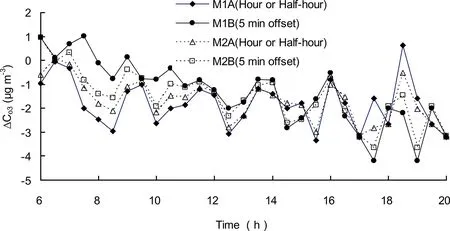
Fig. 6. Diurnal variations of 30-min averaged O3 gradients calculated with two methods and time ranges on 15 August 2017. M1A: Method I and start times are on the hour or halfhour; M1B: Method I but start times are 5-min delayed; M2A:Method II and start times are on the hour or half-hour; M2B:Method II but start times are 5-min delayed.
3.3. Comparison of O3 fluxes measured with the EC and different gradient methods
Figure 7 presents the mean diurnal variations of the O3fluxes with different methods. The disparities in the O3fluxes with different methods were small in the morning and large in the afternoon. This is primarily because the gradient was relatively large in the afternoon (see Fig. 5). As the analyzer's random error is relatively small and stable, its effect on the O3flux will decrease at a large gradient. Relatively, the O3flux calculated by the AGEC method( FO3_AGEC) is closest to FO3_EC. The MBR O3flux (FO3_MBR)i s lower than FO3_EC, and the AG O3flux (FO3_AG) in the afternoon is about twice as large as FO3_EC.
Figure 8 shows comparisons of daytime O3fluxes calculated by the EC method (FO3_EC) and the FO3calculated by different gradient methods. Overall, the correlations between FO3_ECand O3fluxes with different gradient methods are not good. To analyze the relationships between FO3_ECand the fluxes from different gradient methods, two types of linear regression equations were calculated. Type 1 is the general linear regression equation, and type 2 is the linear equation with the intercept phased to zero, reflecting the relationships between the two mean fluxes. Relatively, the gradient method’s O3flux with AGEC is the best, with the largest R2(0.1845), and the slope of the type 2 linear regression curve is closest to the 1:1 line (Fig. 8b). The low correlations show that the gradient O3fluxes were not very reliable.
A few previous studies compared the gradient O3flux with that of the EC technique and found that the results varied. Muller et al. (2009) found that the O3flux determined by the gradient method was larger than that of the EC technique at a grassland area. The transfer coefficient was derived by the wind speed gradient and EC momentum flux.It also showed a very large comparison scatterplot, with a slope of 1.19 and a poor R2(0.15). The O3flux with the AGEC method was similar to the results presented by Muller et al. (2009). Loubet et al. (2013) compared the O3fluxes and deposition velocities (Vd) with AG methods and the EC technique over a maize field and showed that the AG method had a roughly 40% larger Vdthan the EC technique. In this study, the AG O3flux was calculated from the product of u*(calculated by the wind speed gradient with a stability correction) by a concentration scaling parameter(determined by the O3concentration gradient with a stability correction). The FO3calculated with the AGmethod is close to these results. Keronen et al. (2003) found that the Vdvalues determined by the AG method and EC technique generally agreed well in a Nordic pine forest, as did Stella et al. (2012) over bare soil in Paris. Droppo (1985) found that the Vddetermined with the MBR method was close to that of the EC method at a Northeastern U.S. grassland site.Although the O3flux with the AGEC method approaches that of the EC method in these results, the agreement is not very good.
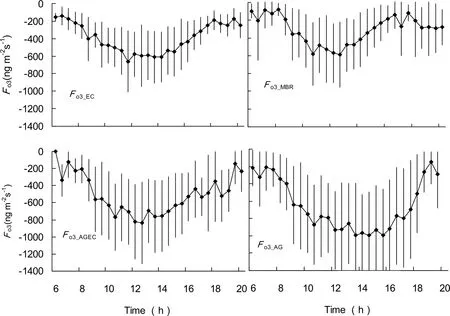
Fig. 7. Mean diurnal variations of the O3 fluxes estimated by different methods. The top and bottom of the vertical lines represent the mean ± std.
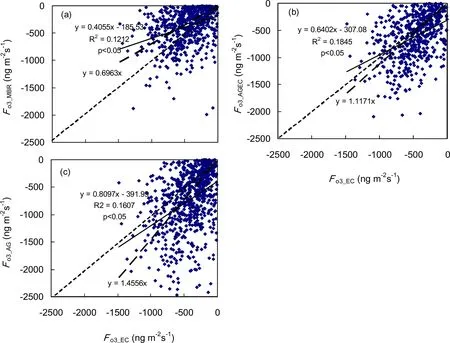
Fig. 8. Comparisons of 30-min O3 fluxes estimated by different gradient methods and the EC method’s flux.
The errors of the gradient method’s fluxes come from the joint effects of the exchange coefficient and gradient.The theoretical basis of the gradient method is MOST, but it is limited to the homogeneous surface layer (or constantflux layer) above the roughness sub-layer, and a range of|z/L|≤1~2 (Foken, 2006). The large discrepancy among the O3fluxes with different methods may be related to the nonideal conditions. For example, the sensors’ heights were not elevated enough, and the turbulent intensity was not always strong enough. Rinne et al. (2000) summarized the sources of uncertainty with AG methods for hydrocarbon flux measurements and presented the error estimate of gradient measurements, turbulent exchange coefficients, and parameterizations. The uncertainty caused by the gradient measurement was the largest. Loubet et al. (2013) also analyzed the potential errors in the AG method. They included the non-stationarity of the concentration changes, temperature errors caused by shields, roughness sub-layer correction issues, uncertainty in the displacement height estimation, etc. Based on this error source analysis, the most important error source was determined to be the gradient measurement. Decreasing the uncertainty in the O3gradient is the key to more accurately estimating the O3flux for gradient methods. Increasing the number of analyzers and measuring levels might reduce the errors in the O3gradient. The gradient calculated using only the two-level O3concentrations can easily produce random errors.
4. Conclusions
In this study, we evaluated the performance of different gradient methods for the O3flux measurement by comparing them with the EC O3flux. The accuracy and precision of the gradient method O3flux rely on the measurement and calculation methods of the exchange coefficients and concentration gradients. The following conclusions can be drawn from our results.
The exchange coefficients calculated with different methods showed similar diurnal variation patterns. The coefficient calculated using the EC measurements (KAGEC) is the most accurate. On average, the coefficient computed by the MBR method (KMBR) is 40% lower than KAGEC, and the coefficient based on the AG method (KAG) is 25% higher than KAGEC.
Because of the small concentration difference in two layers over the maize field, the bias and uncertainty of the O3gradient mainly depend on the analyzer’s precision. Meanwhile, measurement and calculation methods are also important sources of error for the O3gradient and should be paid attention. When using one analyzer to cyclically measure the two-level O3concentrations, the effect of the fast O3concentration changes on the O3gradient must be eliminated.Using two analyzers and periodically exchanging the sampling position to measure two-height O3concentrations is a better option.
By comparing the gradient’s O3fluxes with that of the EC technique, we found that the correlations between the FO3_ECand FO3with gradient methods are not very good.The accuracy of the gradient method is dependent on the exchange coefficient method, and the precision is related to the quality of the O3gradient measurement. On average, the gradient method O3fluxes with the AG, AGEC, and MBR methods were 30.4% lower, 11.7% higher, and 45.6%higher than FO3_EC, respectively. The O3fluxes determined with the AGEC method are the closest to that determined with the EC technique.
Acknowledgements.This work was supported by the National Key R&D Program of China (Grant No. 2017YFC0503 801), and National Natural Science Foundation of China (Grant No. 41675147).
 Advances in Atmospheric Sciences2020年6期
Advances in Atmospheric Sciences2020年6期
- Advances in Atmospheric Sciences的其它文章
- Estimate of Hydrofluorocarbon Emissions for 2012-16 in the Yangtze River Delta, China
- Deriving Temporal and Vertical Distributions of Methane in Xianghe Using Ground-based Fourier Transform Infrared and Gas-analyzer Measurements
- Direct Observations of Atmospheric Transport and Stratosphere-Troposphere Exchange from High-Precision Carbon Dioxide and Carbon Monoxide Profile Measurements
- An Observing System Simulation Experiment to Assess the Potential Impact of a Virtual Mobile Communication Tower-based Observation Network on Weather Forecasting Accuracy in China. Part 1: Weather Stations with a Typical Mobile Tower Height of 40 m
- On the Epochal Variability in the Frequency of Cyclones during the Pre-Onset and Onset Phases of the Monsoon over the North Indian Ocean
- Relationship between Solar Wind-Magnetosphere Energy and Eurasian Winter Cold Events
